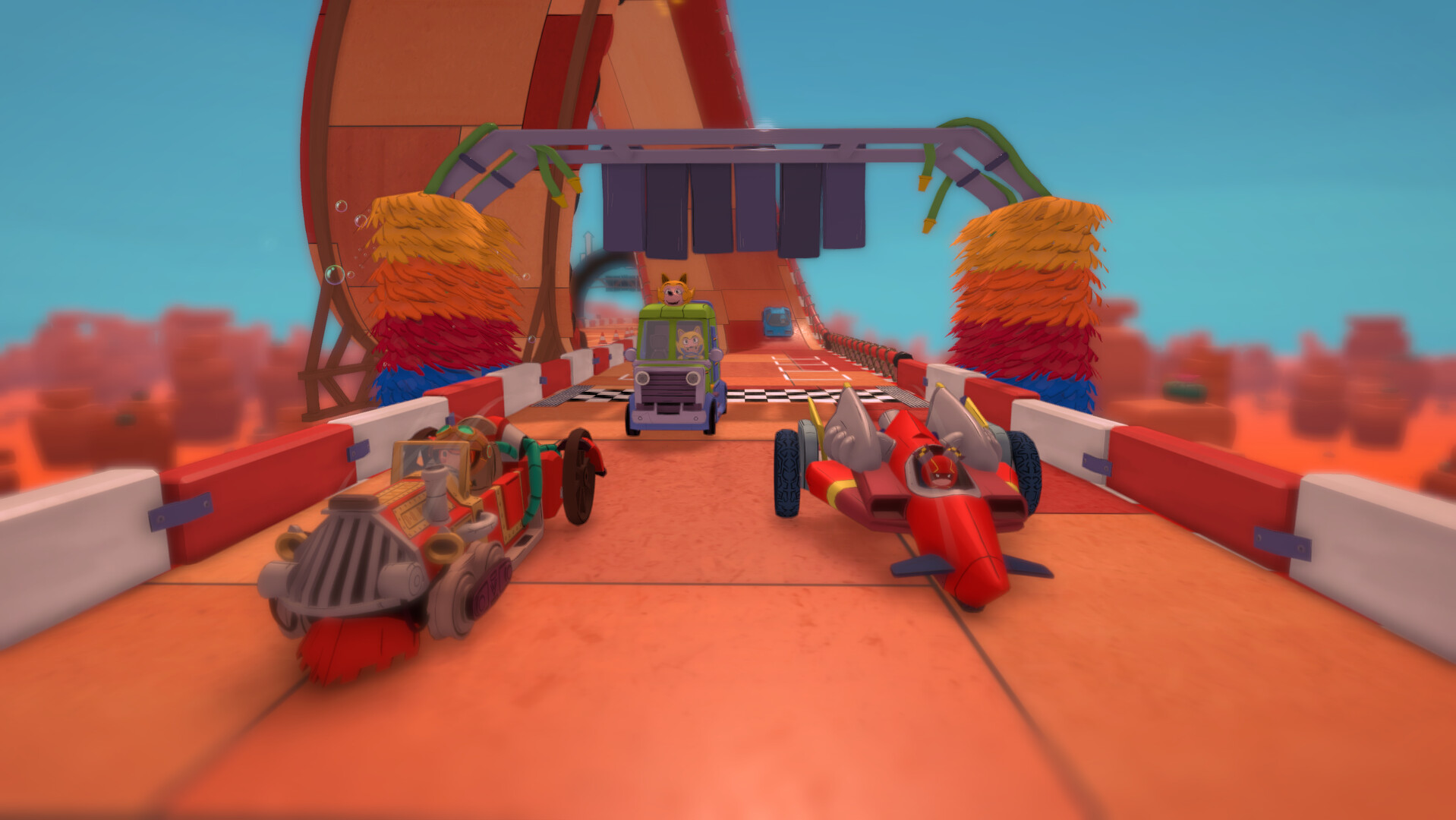
If you’re looking for a game that captures the old-school arcade top-down racing experience, Make Way seems to be making that very promise, while introducing some interesting wrinkles of its own. With its promise of arcade multiplayer action and a core loop that’s as focused on building tracks as it is on racing through them, Ice Beam’s upcoming racer has certainly caught the eye. Curious to learn more about what we can expect from the game and the experience it will offer upon release, we recently reached out to its developers with a few of our questions. Below, you can read our interview with Make Way’s lead developer, Tom Goodchild.
"I wanted to replicate that “classic” top-down racing elimination feel that I was a huge fan of, but I needed a new twist to add something fresh to the idea, so people would sit-up and take notice."
Make Way is taking a very different approach to delivering a multiplayer racing experience. How did the concept for the game first come about? What did you identify as the experience’s key pillars early on?
Well, my first design decisions were really based around what I could feasibly ship in Unity with a minimal team. I know it sounds boring, but I needed to make something that I had full confidence I could deliver on time and within budget.
I knew I wanted something that was couch co-op, most likely with a single screen / camera view, so I started prototyping various ideas. At one point I had a very simple prototype of a co-op game where you played as removal men called Take Out – can you believe? Luckily, the prototype didn’t play that well, so I ditched the idea. This was about 6 months before Moving Out was announced, so I dodged a bullet with that one!
I had previously been lead designer on Toybox Turbos while I worked at Codemasters. I always felt like I had “unfinished business” with the concept, so I decided to return to the idea.
I wanted to replicate that “classic” top-down racing elimination feel that I was a huge fan of, but I needed a new twist to add something fresh to the idea, so people would sit-up and take notice.
Initially, I thought that the tracks would be already built, and you would add hazards and features to it, but after some thought and experimentation, it occurred to me that building the actual track might be more interesting.
So, I added these simple track pieces you could snap together, and then added the simple “pick->build->race” loop, and immediately knew I was onto something. It just worked off the bat.
How flexible will Make Way’s track creation toolset be? What level of freedom can players expect in the sort of tracks they’ll be able to make?
The building system is designed to be quick and easy to use and allows for any type of track to be built. There is a validation system, and as long as the track pieces don’t intersect, you can build what you want.
It isn’t really a game about building a track with any sort of intention. It’s all about frantically building something fast, with each player having their own priorities about what they are trying to achieve. This usually means the final track is tangled mess of slopes, corners and hazards. But because players have “only themselves to blame” when it comes to how difficult the track is, it remains fun.
The level of inventiveness and variety the game’s exhibiting in the obstacles players will be able to place on tracks is impressive to see, but as developers, how do you strike the right balance between coming up with imaginative new track elements that don’t break the game’s balance?
Making a party game is all about playtesting the core experience. We playtested a new version of the game each Friday for over a year(!), which was A) was a ton of fun and B) vital to the balancing of the game. This was the first step in getting the different elements of the game to feel good, and to get everything to interact with everything else without bugs or issues.
After the initial balancing, we then took the game to local indie game meets and other local events to get playtesting feedback from the actual public. This is a vital step as it weeds out the issues that us “experts” at the game don’t see. It also usually results in the game getting easier, as I have a habit of balancing any game I work on for myself, which usually results in the game being WAY too hard.
"There were various discussions about the vehicles (and drivers), and the approach we decided on was to look at them as simple “avatars”, similar to Fall Guys. That means all vehicles have identical handling, and the variations are purely aesthetic."
What can you tell us about Make Way’s progression mechanics, in terms of allowing players to unlock new track pieces and vehicles?
The game has a simple unlock system based on the amount of XP you earn. The player can earn experience from doing various actions while playing the game either alone, in local or online multiplayer. The XP has “levels” which reward the player with new vehicles, special track pieces, and hazards / features. The XP / level also unlocks the more chaotic game modes.
One of the key lessons I took away from those public playtests was that the game is a lot of fun, but it can be VERY overwhelming to new players. The primary motivation for this system was to restrict players from trying out the more difficult game modes when they haven’t got much experience. But it’s also a nice way of motivating the player to return to the game.
What level of variety can players expect from the game’s roster of vehicles?
There were various discussions about the vehicles (and drivers), and the approach we decided on was to look at them as simple “avatars”, similar to Fall Guys. That means all vehicles have identical handling, and the variations are purely aesthetic.
That said, visually, there are big differences between the vehicles. There are rocket cars, dune buggies, monster trucks, American muscle cars, e-cars, European sports cars, Tuk-tuks, and even a UFO. So, hopefully, something for everyone!
Make Way is placing a great deal of emphasis on multiplayer, but for those looking for solo experiences, will the game have any single player-focused content on offer?
The entire game is playable by yourself, and you can unlock all of the content offline. That said, it was intentionally made as a party game, and is at its best when you are sat next to your friends, drink in hand, playing into the wee hours.
Will the game allow players to play offline against bots?
You can play offline against bots, yes. It’s a good way to learn how the game’s mechanics work. We decided to not allow bots in online games, mostly because of the performance overhead on some platforms, like the Switch.
Will Make Way support cross-platform multiplayer?
Yes, the game has cross-play. It should be noted that the game is peer-to-peer and doesn’t have dedicated servers. If the game is successful, dedicated servers is something we can definitely look at in the future.
"Yes, the game has cross-play. It should be noted that the game is peer-to-peer and doesn’t have dedicated servers. If the game is successful, dedicated servers is something we can definitely look at in the future."
What frame rate and resolution will the game target on the PS5 and Xbox Series X/S?
Both the PS5 and Xbox Series X games render at 4K, with the Series S version rendering at a lower 1440p resolution. PS5 and Xbox Series run at 60fps. The reason we don’t run the game at 120hz is actually because the peer-to-peer network solution needs all platforms to run at the same frame-rate.
Also, both the PS4 and Xbox One versions run at 1080p at 60hz as well!
What frame rate and resolution will the game target on the Switch in docked and undocked modes?The Nintendo Switch targets 1080p docked, and 720p in handheld mode, but does have a dynamic resolution to prioritise performance. It also targets 60hz, but can dip below this when things get busy on certain levels. Optimisations are still ongoing, so these frame drops might be completely eliminated by release. No promises though!
What are your thoughts on the Steam Deck? Do you have plans for any specific optimizations for the device?
Oh, I love my Steam Deck. It’s a great device when on the go, and being able to revisit my entire Steam back catalogue means it’s always with me when I go on holiday! (I played the entirety of “Dave the Diver” on my Deck).
As for “specific optimizations” for the Steam Deck, there aren’t any to speak of. The machine is so powerful, we have all of the same high level post processing effects running on it, including MSAA, high quality depth of field, and ambient occlusion, and the thing doesn’t drop a single frame. It’s a beast!

















